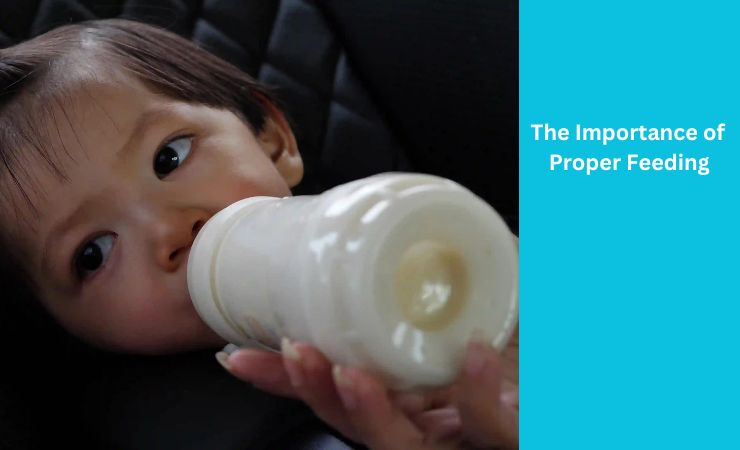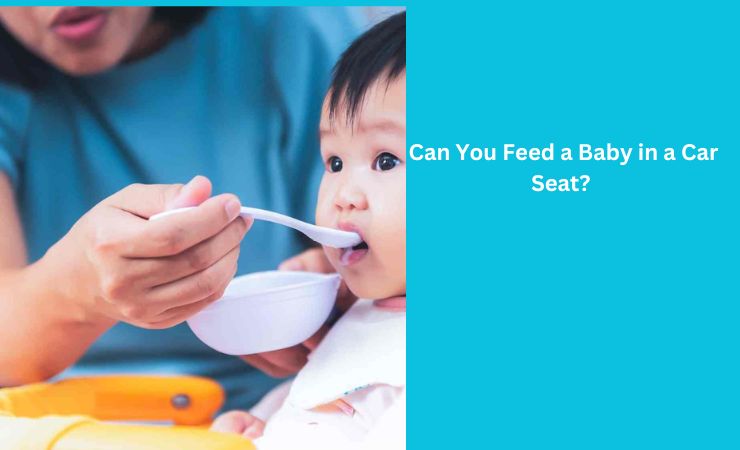Can You Feed a Baby in a Car Seat? Lets discuss about in details.
Curious minds wonder: Can You Feed a Baby in a Car Seat? Let’s embark on a journey to discover the ins and outs of this everyday parenting conundrum.
While it might seem convenient, it’s safer to avoid feeding a baby in a car seat while the vehicle is in motion; pull over to feed your baby securely.
Balancing convenience and safety, we’ll unveil tips and insights that ensure feeding time remains a joyful and secure experience.
So, fasten your seatbelts as we navigate the realm of feeding your baby in a car seat – a blend of comfort, safety, and precious bonding.
Also read: How To Loosen Graco Car Seat Straps
Can You Feed a Baby in a Car Seat?
Feeding a baby in a car seat is generally not recommended as it poses potential risks to the baby’s safety and well-being.
Car seats are designed to protect infants during car rides and maintain their proper positioning during sudden stops or collisions. They are not designed to serve as feeding stations.
When a baby is placed in a car seat, they are in a reclined position with limited mobility.
Feeding a baby in this position can lead to various issues.
For instance, the baby might have difficulty swallowing properly, as the reclined angle can cause milk to flow into the windpipe instead of the stomach.
This increases the risk of choking and aspiration.
Feeding a baby in a car seat can also compromise the baby’s overall comfort.
Babies need a stable and supportive environment for feeding, allowing them to latch properly and consume their meals relaxed.
The confined space of a car seat can hinder this process, leading to frustration for both the baby and the caregiver.
Suppose you need to feed your baby while on the road; it’s recommended to make a brief stop and find a safe and comfortable location for feeding.
This could be a rest area, a park bench, or any place where the baby can be properly cradled and supported during feeding.
Ensuring the baby’s safety and well-being should always be the top priority, even when faced with the challenges of on-the-go parenting.
The Importance of Proper Feeding

Proper feeding is of paramount importance when it comes to maintaining good health and well-being.
Also, proper feeding is paramount for individuals of all ages, as it directly impacts overall health, growth, and well-being.
Proper feeding is especially critical for infants and children as it lays the foundation for their physical and cognitive development.
Adequate nutrition during the early years supports brain development, immune system strength, and the establishment of healthy eating habits.
In children and adolescents, balanced nutrition fuels growth supports organ function, and provides the energy required for physical activities and academic performance.
Essential nutrients like vitamins, minerals, proteins, and carbohydrates aid in building strong bones, maintaining healthy body weight, and preventing various health issues.
In summary, proper feeding is integral to the health and well-being of individuals across all life stages.
It influences growth, development, disease prevention, and overall quality of life.
Educating oneself about nutritional needs and making informed food choices is an investment in long-term health and vitality.
What are Suitable Food Options for my Child While I’m Driving?
When feeding your child while driving, safety should be your top priority. Here are some safe and convenient options:
Pre-packaged Snacks
Opt for snacks like granola bars, cheese sticks, trail mix, or pre-cut fruits that are easy to handle and less messy.
Finger Foods
Choose easy-to-eat finger foods that your child can manage independently.
Examples include carrot sticks, cucumber slices, apple slices, and crackers.
Sippy Cups
Provide a sippy cup with water or a non-staining beverage to keep your child hydrated without the risk of spills.
Sandwiches
Prepare simple sandwiches like peanut butter and jelly or turkey and cheese.
Cut them into manageable sizes beforehand for easy consumption.
Bento Boxes
Use divided containers to create a balanced meal with small portions of different foods, such as cheese cubes, sliced grapes, and small sandwiches.
Yogurt Pouches
These are convenient and mess-free options for dairy intake. Ensure they’re securely closed to avoid spills.
Avoid Messy Foods
While on the road, avoiding being messy or prone to causing stains, like sauces, soups, or foods that crumble easily, is best.
Safety First
Ensure your food doesn’t require your child to be buckled in or restrained while eating.
Avoid choking hazards like whole grapes, nuts, or hard candies.
Plan Ahead
Pre-prepare the food and have everything ready before driving to minimize distractions.
Pull Over
If your child needs assistance or is eating a meal that requires more attention, consider pulling over at a safe spot to tend to their needs.
Remember, safety should always come first.
Keep your focus on the road, and if your child requires attention that could lead to distraction, it’s best to find a safe place to stop before tending to their needs.
Foods to Avoid Giving Your Baby While In a Car

Feeding your baby in a car requires extra caution to ensure their safety and well-being.
Here’s a list of foods to avoid giving to your baby while in a moving vehicle:
Choking Hazards
Avoid foods with a high risk of choking, such as whole grapes, cherry tomatoes, nuts, hard candies, popcorn, and chunks of meat or cheese.
Sugary Foods
Sugary snacks and candies can contribute to tooth decay and may not provide the necessary nutrition for your baby.
Large Pieces
Foods that require extensive chewing or are difficult to swallow should be avoided. This includes large chunks of fruits, vegetables, or meats.
Messy or Staining Foods
Foods that can easily spill or stain, such as sauces, juices, or foods with vibrant colors, should be avoided to prevent messes in the car.
High-Risk Allergens
Avoid introducing allergens like peanuts, tree nuts, shellfish, and eggs without consulting your pediatrician first.
Unpasteurized Foods
Avoid unpasteurized dairy products and juices as they may carry a higher risk of foodborne illnesses.
Hot Foods
Never give your baby hot foods or beverages to prevent burns while in a moving vehicle.
Processed and Fast Foods
Highly processed snacks, fast food items, and sugary drinks lack essential nutrients and can contribute to an unhealthy diet.
Small Toys or Objects
While not food, keeping small toys, objects, or pieces that could pose a choking hazard away from your baby in the car is important.
Caffeinated Beverages
Caffeinated beverages, such as coffee or energy drinks, are unsuitable for babies and should be avoided.
Unfamiliar Foods
Stick to foods your baby is accustomed to. Introducing new foods while on the road might lead to adverse reactions.
Alcoholic Beverages
This goes without saying, but alcoholic beverages should never be given to babies.
Remember, safety is paramount. Always prioritize your baby’s well-being and minimize distractions while driving.Finding a safe place to pull over and tend to their needs is best if your baby requires attention beyond what can be safely provided while driving.
Also read: How To Put Car Seat In Shopping Cart
What Should I Consider When Feeding My Baby In A Car Seat?
Feeding your baby in a car seat requires careful consideration to ensure their safety and comfort. Here’s what you should keep in mind:
Safety First
The safety of your baby is paramount.
Avoid feeding your baby while the car is in motion.
Pull over to a safe location if your baby needs to be fed.
Ensure your baby is properly secured in the car seat according to the manufacturer’s instructions.
The harness should be snug and secure, with no bulky clothing that could interfere with the harness’s effectiveness.
Age and Development
Consider your baby’s age and developmental stage.
Babies starting to eat solid foods may require more assistance, while older babies can handle finger foods more independently.
Appropriate Foods
Choose foods suitable for your baby’s age and ability to chew and swallow.
Opt for soft, easy-to-digest foods for younger babies and small, manageable finger foods for older ones.
Prepare the food in advance to minimize distractions while driving. Cut fruits and vegetables into small, safe pieces and have everything ready.
Avoid Choking Hazards
Avoid giving foods that pose a choking risk, such as small, hard foods like nuts or foods with tough skins that can’t be easily chewed.
Select foods that are less likely to create a mess. Avoid foods with sauces or excessive drips that could lead to staining or distraction.
Temperature
Ensure the food is appropriate before offering it to your baby. Hot foods can cause burns, while cold foods might not be as enjoyable.
Bottle Feeding
If you’re bottle-feeding, consider using a bottle holder that attaches securely to the car seat.
This allows your baby to feed comfortably without the risk of the bottle falling.
While feeding, always keep an eye on your baby. Avoid leaving your baby unattended with food, especially in the car.
Hydration
Keep your baby hydrated, especially during longer journeys. Offer water in a sippy cup to prevent dehydration.
As the driver, your focus should primarily be on the road.
If feeding your baby becomes too distracting, waiting until you can safely stop is better.
Always prioritize your baby’s well-being and safety.
If the feeding situation becomes too complex to manage while driving, find a safe place to stop and attend to your baby’s needs.
Also read: Is It Illegal To Use An Expired Car Seat
Is it Safe to Feed a Baby in a Car Seat?

Feeding a baby in a car seat raises safety concerns due to several factors.
Car seats are designed with specific safety features to protect infants during travel, including harnesses that secure them in case of sudden stops or collisions.
Feeding a baby while the car is in motion compromises these safety mechanisms, increasing the risk of injury in case of unexpected jolts.
Additionally, focusing on feeding can divert the driver’s attention from the road, heightening the potential for accidents.
Choking hazards are also more pronounced when feeding a baby in a car seat.
Monitoring a baby’s feeding is challenging while driving, making it harder to react promptly if choking occurs.
Moreover, attempting to feed a baby in a car seat might lead to discomfort, frustration, and potential spills.
In many regions, laws mandate that babies be properly secured in car seats while the vehicle is in motion.
Feeding a baby in a car seat could violate these regulations.
To prioritize safety, it’s advisable to pull over at a safe location if your baby needs to be fed, allowing you to address their needs without compromising their well-being or the safety of the journey.
Tips For Feeding Your Baby In a Car Seat
Feeding your baby in a car seat demands special consideration for safety and convenience.
Prioritize safety by never feeding while the car is in motion; find a safe spot to pull over.
Prepare in advance by having bottles, formula, or appropriate foods ready.
Opt for easily manageable finger foods or pre-cut fruits to minimize mess. Avoid choking hazards like small, hard items.
Use spill-proof sippy cups and consider attachments to secure them. Stay attentive to the road and limit distractions.
Ensure your baby’s comfort by adjusting seat straps and padding.
If feeding proves too distracting, wait until you can safely stop.
Hydration is vital, so offer water in a sippy cup during longer journeys.
Practice feeding in the car seat when stationary before attempting it while driving.
Safety and focus on driving should always take precedence.
Frequently Asked Questions (FAQs) of Can you Feed a Baby in a Car Seat

- Is it secure to bottle-feed a baby in a car seat?
No, it’s not safe to bottle feed a baby in a car seat while the car is in motion. Pull over to a safe spot first.
- When does the 2-hour car seat rule end?
The 2-hour car seat rule typically ends when your baby reaches 2 years old, as they can transition to a forward-facing car seat. Feeding a baby in a car seat Reddit Feeding a baby in a car seat is not recommended due to safety concerns and potential distractions while driving.
- Is it safe to bottle-feed a baby in a car seat on Reddit?
Most Reddit discussions advise against feeding a baby in a car seat due to safety risks and potential legal issues.
- Can you take a baby out of a car seat while driving?
Taking a baby out of a car seat while the vehicle is in motion is extremely unsafe. Always ensure they’re properly secured.
- How do you burp a baby in a car seat?
Gently pat or rub your baby’s back while they’re in the car seat. Ensure their head and neck are well-supported.
- Can I breastfeed my baby in the car?
Yes, you can breastfeed your baby in the car when it’s parked in a safe location. Use a nursing cover or find a private spot if needed.
Wrap It Up
Feeding a baby in a car seat is tempting, but safety is key.
I know convenience matters, but it’s crucial to pull over and ensure your baby’s secure for feeding.
Remember, a quick stop guarantees both safety and a peaceful mealtime.
Stay safe, and enjoy those precious moments with your little one!
Hope you learned detailed about can you feed a baby in a car seat?

